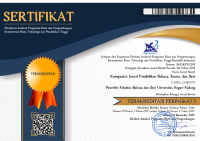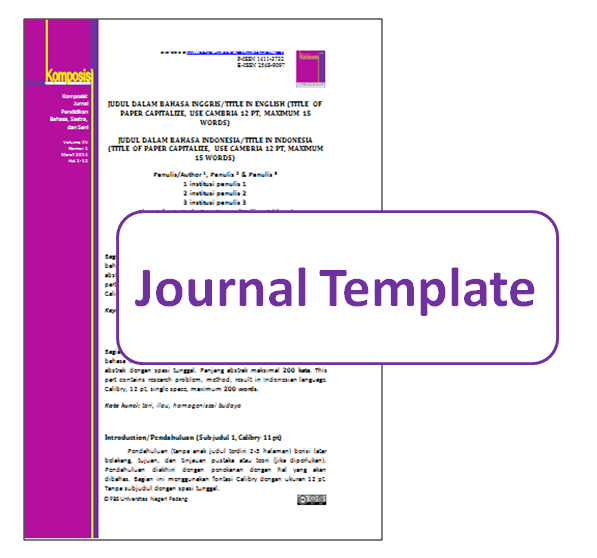COREOGRAPHY IN MALAYSIA IN MULTICULTURAL CONCEPT: CASE STUDY PROGRAM MINOR ARTS DANCE UPSI
Nerosti Nerosti
Abstract
KOREOGRAFI DI MALAYSIA DALAM KONSEP MULTIKULTURAL: KAJIAN KES PROGRAM MINOR SENI TARI UPSI
Abstract
This writing is the result of my research entitled “Analisis Deskriptif Koreografi Pelajar Minor Seni Tari UPSI: Kajian Kes Tiga Produksi Tari 2008 – 2011”. The aim of the research is to answer the question: To what extend the dance work by Minor Dance Art students which was presented in Art Dance Production fulfills the coreography elements, by using descriptive analysis method from primary and secondary data. By using qualitative approach which involved library research, observation, interview and by using coreography theory, the research result proves that seventeen Minor Art Dance students’ dance works has been fulfilled the coreography elements. The elements are (a). The choice of theme or idea of work with the early stimulus, that is the stimulation of idea and concept, cinestetic, auditive, and visual. (b). Exploration and improvitation (c). Smoothing and composition. The composition elements has also been described, which include (1). The structure of the work (2). The body movement of the dancer (3). Th floor pattern (4). Music and lighting (5). Costum and make up, lighting. The research also found that eleven of students’ dance works has applied the multicultural concept which has ethnic and classic themes. The multicultural which is viewed as various of uniqueness and the diversity of the cultural ethnic, reflected by each work that is limited by historical context, social, and the origin culture, that includes Melayu ethnic, Minangkabau, Java, Sabah and Serawak, Kelantan, Hindia, and Chinese. Those eleven dances are Andai Randai, San Kipas, Iras, Ngayau, Tatoo Gendup Berpantang, Gawai Batu, Sekar Wangi, Kondattam, Sense of Beauty, Cinta Za’yu dan Jepit.
Keywords: Multicultural, Minor Dance, Coreography
Abstrak
Tulisan ini merupakan hasil penelitian saya yang berjudul "Analisis Deskriptif Koreografi Pelajar Minor Seni Tari UPSI: Kajian Kes Tiga Produksi Tari 2008 - 2011". Tujuan dari penelitian ini adalah untuk menjawab pertanyaan: Untuk memperluas tarian para siswa Seni Tari Minor yang dipresentasikan dalam Art Dance Production memenuhi elemen-elemen inti, dengan menggunakan metode analisis deskriptif dari data primer dan data sekunder. Dengan menggunakan pendekatan kualitatif yang melibatkan penelitian kepustakaan, observasi, wawancara dan dengan menggunakan teori inti, hasil penelitian membuktikan bahwa tujuh belas karya tari tari Seni Tunggal telah memenuhi unsur-unsur inti. Unsur-unsurnya adalah (a). Pilihan tema atau ide kerja dengan stimulus awal, yaitu stimulasi ide dan konsep, cinestetic, auditive, dan visual. (B). Eksplorasi dan peningkatan (c). Smoothing dan komposisi. Unsur komposisi juga telah dijelaskan, yang meliputi (1). Struktur pekerjaan (2). Gerakan tubuh para penari (3). Pola lantai (4). Musik dan pencahayaan (5). Costum dan make up, lighting. Penelitian ini juga menemukan bahwa sebelas karya tari siswa telah menerapkan konsep multikultural yang memiliki tema etnik dan klasik. Multikultural yang dipandang beragam keunikan dan keragaman etnik budaya, tercermin dari setiap karya yang dibatasi oleh konteks sejarah, sosial, dan budaya asal, yaitu etnis Melayu, Minangkabau, jawa, sabah dan Serawak, Kelantan, Hindia, dan Cina. Sebelas tarian tersebut adalah Andai Randai, San Kipas, Iras, Ngayau, Tatoo Gendup Berpantang, Gawai Batu, Sekar Wangi, Kondattam, Rasa Kecantikan, Cinta Za'yu dan Jepit.
Kata kunci : Multikultural, Tari Kecil, koreografi
References
Bagus, I Gusti Ngurah (2001). Reformasi, Multikulturalisme, Dan Masalah Politik Bahasa Indonesia, Makalah disampaikan pada Kongres Bahasa Jawa III. Yogyakarta: Badan Pekerja Kongres Bahasa Jawa.
Buku Program ReTari 2011.
Chris Barker. (2000) Cultural Studies.: Theory and Practice. London: Sage Publications.
Gonzales, Joseph (2004). Choreography A Malaysian Perspective.Kuala Lumpur: Akademi Seni Kebangsaan.
George Ritzer Doughlas j. Goodman (2004) Sociological Theory .terjemahan Nurhadi “Teori Sosiologi: Teori Sosiologi Klasik Sampai Perkembangan Mutakhir “. Edisi terbaru. New York: McGraw-Hill.
Hawkins, Alma M. (2002) Moving From Within: A New Method for Dance Making.Terj. I Wayan Dibia.Bergerak Menurut Kata Hati: Metoda Baru dalam Mencipta Tari. Denpasar: ISI.
Kurath, Getrude Prokosh. (1960) “Panorama of Dance Ethnology” dalam Jurnal Current Anthropology.
Royce, Anya Peterson. (1977) Anthropology of Dance.Indiana: Bloomington.
Sandra Cerny Minton. 1986. Choreography – A Basic Approach Using Improvisation (2nd edition). Human Kinetics
Siegel, Marcia B. The Shapes of Change: Image of American Dance. Houghton Miflin Company. Boston. 1979.
Smith. Jacqueline. Komposisi Tari: Sebuah Petunjuk Praktis untuk Guru. Terj. Ben Suharto. Yogyakarta: Ikalasti. 1985.
Sunderland. Margot. 1990. Choreography the Stage Musical. New York: J. Garnet Miller LTD
DOI:
https://doi.org/10.24036/komposisi.v15i2.7498
Refbacks
There are currently no refbacks.
Copyright (c) 2017 Komposisi: Jurnal Pendidikan Bahasa, Sastra, dan Seni
Komposisi: Jurnal Pendidikan Bahasa, Sastra, dan Seni , a peer-reviewed online journal in languages, literature, and arts education.
Printed ISSN 1411-3732 , Online ISSN 2548-9097 .
Currently, Komposisi: Jurnal Pendidikan Bahasa, Sastra, dan Seni is indexed by: View My Stats
Visitors since February 2017:
<div class="statcounter"><a title="web analytics" href="http://statcounter.com/" target="_blank"><img class="statcounter" src="//c.statcounter.com/11239717/0/d5796c6b/0/" alt="web analytics"></a></div> View My Stats
Published by:
Universitas Negeri Padang (UNP) Address: Faculty of Languages and Arts (FBS) Universitas Negeri Padang. Jl Prof. Dr. Hamka Air Tawar Barat, Padang - West Sumatera -Indonesia Telp/Fax. +62751 7053363 Home page: http://ejournal.unp.ac.id/index.php/komposisi | e-mail:komposisi.fbsunp @ fbs.unp.ac.id | cc: havid_a @ fbs.unp.ac.id
Server Luar
slot88
King Wood Car Care slot gacor
scam
situs toto
bandar togel
bandar togel
Slot Gacor Hari ini
situs toto
situs toto
toto togel
togel online
topup murah
harapan777
AMDBET
toto togel
slot88
login bayar4d
macau303
slot resmi apk slot online Slot Maxwin
situs toto
sakti55
situs toto felix168
nextogel
NEXTOGEL
NEXTOGEL
NEXTOGEL
NEXTOGEL
NEXTOGEL
NEXTOGEL
NEXTOGEL
NEXTOGEL
NEXTOGEL
NEXTOGEL
NEXTOGEL
NEXTOGEL
NEXTOGEL
NEXTOGEL
NEXTOGEL
NEXTOGEL
NEXTOGEL
NEXTOGEL
NEXTOGEL
NEXTOGEL
NEXTOGEL
NEXTOGEL
NEXTOGEL
NEXTOGEL
NEXTOGEL
NEXTOGEL
NEXTOGEL
NEXTOGEL
NEXTOGEL
NEXTOGEL
NEXTOGEL
JEPETOGEL
JEPETOGEL
JEPETOGEL
JEPETOGEL
KIM369
KIM369
KIM369
KIM369
KIM369
KIM369
KIM369
KIM369
KIM369
KIM369
situs toto toto slot kuntogel
situs toto toto slot sendok88
togel online toto slot https://www.eaglehighplantations.id/
toto macau
slot gacor slot gacor
batak5d toto slot Slot88 www.onscripture.com
slot online
situs toto
situs gacor bandar togel resmi toto togel https://montreallawfirm.com
wild west gold sering pecah
Toto 4D
slot88
toto macau
Situs Toto
Situs Toto
https://mercubuana.org/
Toto 4d
toto 4d
Toto 4D
toto 4d
info rtp akurat malam ini
Wanita Subang Beli mobil dari Nolimit city
rahasia Cuan Aztech Gems
Gatot kaca Buat TKW Jadi jutawan
Rahasia sukses bermain Mahjing wins
harapan princess starlight
Harapan sweet bonanza
taktik gates of olympus xmas
dukungan gates olympus
rahasia sukses bermain mahjong ways
Situs togel
slot gacor 2025
luxury89
Sulebet
sulebet
oja89
basic4d
situs toto togel online
vipbet888
momo128 login
https://garudafood.org/
jpmania mesin128
mesin128
mesin128
oja89
slot gacor
jumat4d slot login
https://pintu-pro.id/
slot gacor
Buat yang suka cari link slot gacor hoki69 maxwin tiap hari, ini tempat yang paling sering gue datengin.
choicehomecontractors.com
sarangslot
slot 4d gacor hari ini
Toto 4D
https://up2m.pkr.ac.id/jepangbet/
slot
simpatitogel
slot gacor hari ini
slot gacor
slot
https://unesa.id/











